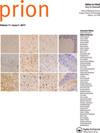A case of V180I genetic Creutzfeldt-Jakob disease presenting with conspicuous facial mimicry
IF 1.6
3区 生物学
Q4 BIOCHEMISTRY & MOLECULAR BIOLOGY
引用次数: 6
Abstract
ABSTRACT Although there have been no reports of facial mimicry in patients with Creutzfeldt-Jakob disease (CJD), we encountered a patient with genetic CJD with prion protein gene codon 180 mutation (V180I gCJD) who apparently showed this interesting clinical finding. The patient was an 87-year-old Japanese woman, and the first observed CJD symptom was poor spontaneity. She gradually showed cognitive dysfunction and subsequently gait disturbance. A prion protein gene analysis revealed a V180I mutation with methionine homozygosity at codon 129. Facial mimicry was observed 7 months after disease onset and continued for approximately 9 months. Pathological laughing and startle reaction were also observed during approximately the same period, whereas myoclonus was observed at a later stage, 12 months after disease onset, and was very mild in degree. Electroencephalography studies showed a diffuse slow basic pattern without periodic sharp wave complexes. Diffusion-weighted magnetic resonance imaging showed extensive hyperintensity in the cerebral cortex, and there was also hyperintensity with edematous swelling in the same regions on T2-weighted and fluid-attenuated inversion recovery images. On the basis of the magnetic resonance imaging findings and the findings of previous case reports of V180I gCJD, we speculate that the characteristic extensive cerebrocortical involvement observed in V180I gCJD was implicated in the pathogenesis of the facial mimicry observed in this case.一例V180I基因型克雅氏病表现为明显的面部模仿
虽然在克雅氏病(CJD)患者中没有面部模仿的报道,但我们遇到了一位携带朊蛋白基因密码子180突变(V180I gCJD)的遗传性CJD患者,他显然表现出了这一有趣的临床发现。患者为一名87岁的日本女性,首次观察到的CJD症状为自发性差。她逐渐表现出认知功能障碍和随后的步态障碍。朊蛋白基因分析显示V180I突变在密码子129处具有蛋氨酸纯合性。在发病7个月后观察面部模仿,并持续约9个月。病理性大笑和惊吓反应也在大约同一时期出现,而肌阵挛在发病12个月后才出现,且程度很轻。脑电图显示弥漫性慢基本型,无周期性尖波复波。磁共振弥散加权成像显示大脑皮层有广泛的高信号,t2加权和液体衰减反演恢复图像在相同区域也有高信号伴水肿性肿胀。根据磁共振成像结果和先前V180I型gCJD病例报告的结果,我们推测V180I型gCJD中观察到的特征性广泛脑皮质受损伤与本病例观察到的面部模仿的发病机制有关。
本文章由计算机程序翻译,如有差异,请以英文原文为准。
求助全文
约1分钟内获得全文
求助全文
来源期刊

Prion
生物-生化与分子生物学
CiteScore
5.20
自引率
4.30%
发文量
13
审稿时长
6-12 weeks
期刊介绍:
Prion is the first international peer-reviewed open access journal to focus exclusively on protein folding and misfolding, protein assembly disorders, protein-based and structural inheritance. The goal is to foster communication and rapid exchange of information through timely publication of important results using traditional as well as electronic formats. The overriding criteria for publication in Prion are originality, scientific merit and general interest.
 求助内容:
求助内容: 应助结果提醒方式:
应助结果提醒方式:


